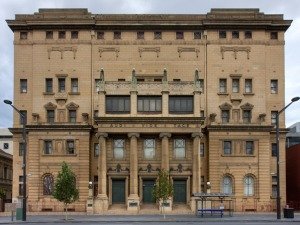By Sarah-Anne Martin
It could be said that within the body of the museum the catalogue is the heart; the museum lives or dies based on its health. Through my directed study project at the Adelaide Masonic Centre Museum, this concept has become very real to me as I work through the collection of 300 plus Past Masters Jewels assigned to me. The reality of my task is that the work that I do now may set the precedent for future cataloguing projects. This, of course, has encouraged me to do my very best and to perform my cataloguing task with accuracy and in a concise manner that could be followed and replicated. I fear that one day I’ll look back on my work as a much more experienced and seasoned heritage professional, and cringe at what is now the very best I can do. Through all this I cannot help but reflect on the process and how tough it can be, especially for small museums, to meet what might be considered ‘best practice’ in collections management.

Figure 1. The Adelaide Masonic Centre Museum’s new heart: the cataloguing program ‘Collections Mosaic’
The Community Museums Program Handbook (Walsh and James 2008), provided to small museums from History SA, has the following to say about museum collections:
Good museum collections are those that are put together with meaning and purpose, rather than those that are created and allowed to grow in an undirected way (Walsh & James 2008:116).
This statement could be considered the idyllic model for museum collections. It seems straightforward enough: collect with purpose and do not let your collection grow without meaning. Granted, this would be ideal, however, for the small museum, this may not be so easy in reality. This could be for a number of reasons:
- The lack of a functional cataloguing and accessioning processes.
- The level of computer literacy required to use cataloguing programs.
- The fear that not accepting items may alienate visitors or offend donors.
- The lack of knowledge or understanding about historical significance.
For the small museum these factors are huge considerations because funds are limited, visitors are sporadic and many of the workers are volunteers and therefore may have varying skills and experience.
On top of all this there is also the consideration of time. This is the first of the cataloguing projects in the Masonic Centre Museum and it will hopefully not be the last, but these things take time. While volunteers are obviously dedicated to the museum, you cannot necessarily ask them to give up the mass of hours necessary to successfully catalogue an entire collection. All of these factors must be considered and balanced carefully. From my perspective this is why working on this directed study project at the Adelaide Masonic Centre Museum is so important, because it is the beginning of addressing these issues and establishing ‘best practice’ for the museum. Before long the museum will be in the best shape of its life.
References
Walsh, K. and A. James 2008 Community Museums Program Handbook. Retrieved 10 August 2013 from http://community.history.sa.gov.au/cmp-handbook.



